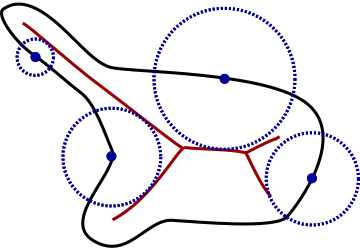Local feature size
Appearance
Local feature size refers to several related concepts in computer graphics and computational geometry for measuring the size of a geometric object near a particular point.
- Given a smooth manifold , the local feature size at any point is the distance between and the medial axis of .[1]
- Given a planar straight-line graph, the local feature size at any point is the radius of the smallest closed ball centered at which intersects any two disjoint features (vertices or edges) of the graph.[2]
See also
[edit]References
[edit]- ^ Amenta, Nina; Bern, Marshall (1999). "Surface reconstruction by Voronoi filtering" (PDF). Discrete and Computational Geometry. 22 (4): 481–504. doi:10.1007/PL00009475.
- ^ Ruppert, Jim (1995). "A Delaunay refinement algorithm for quality 2-dimensional mesh generation". Journal of Algorithms. 18 (3): 548–585. doi:10.1006/jagm.1995.1021.





